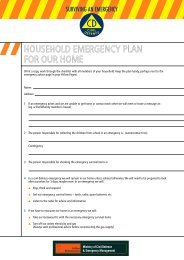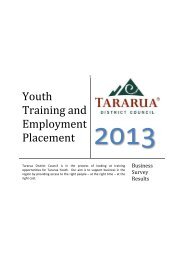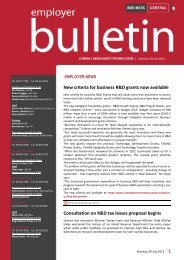Food Control Plan Checklist - Tararua District Council
Food Control Plan Checklist - Tararua District Council
Food Control Plan Checklist - Tararua District Council
- No tags were found...
You also want an ePaper? Increase the reach of your titles
YUMPU automatically turns print PDFs into web optimized ePapers that Google loves.
The Basics<strong>Food</strong> labelling1 Goal 2 Why?To find out which foods need labelling information and whatinformation needs to be on the label.• <strong>Food</strong> for sale in New Zealand must meet the requirementsof the Australia New Zealand <strong>Food</strong> Standards Code.3 How this is donePre-packaged foodPackaged food that is purchased for retail sale is checked tomake sure that the labelling is in English, is legible, and includes:• quantity marking (eg, net weight)• name and address of manufacturer, or supplier or importerwithin New Zealand or Australia• appropriate date marking• statement of ingredients (if needed)• nutrition information (if needed)Labels must also meet any food identification requirementsand if appropriate:• any specific standards• warning and/or advisory statements• instructions for storage and useBulk foods bought in for repackaging<strong>Food</strong> that is repackaged for retail sale is checked for labellingrequirements using NZFSA’s Labelling Guide.If labels are required the product information supplied withthe bulk food is used as a basis to develop labels for therepackaged food.<strong>Food</strong>s made and packaged on siteAll foods that are being made and packaged for retail saleare checked for labelling requirements using NZFSA’s LabellingGuide.What food will not require labelling?The following foods are generally unlikely torequire full labelling:• food made and packaged on the premisesfrom which it’s sold• food delivered packaged and ready-to-eatat the express order of the purchaser(eg, delivered pizza)• food packed in the presence of the purchaser• food sold at a fund-raising event• food sold from an assisted display cabinet(eg, deli counter).It is important however to still use the LabellingGuide to check whether there are any productspecificlabelling requirements for the food.Although some food will not require a label, youmay still be required to provide certain informationspecific to the product if a customer asks for it,such as:• does this food contain an allergen?• how much apple is in this apple pie?• how can I safely store and cook this product?• when should I eat it by?Making a labelBegin by writing down your recipe and ingredients.Work through NZFSA’s Labelling Guide filling in thesummary in Section 15 as you go.A copy of the Labelling Guide can be found at:www.nzfsa.govt.nzProviding information when labelling is notlegally requiredIt is good practice to always provide informationon a product label even if it is not legally required.Consider including the following:• name or description of the food• lot identification (date or batch number)• your business name and address• a ‘Use By’ date if the food must be consumedby this date for food safety reasons• directions for use and storage• any of the common food allergens present inthe product.4 What if there is a problem?Your local council will be able to advise you where to getfurther information.For labelling very complex products, a food safety consultantor legal professional will be able to advise you further.5Write it downKeep your completed labelling checklists ina file - they will be a record of how youhave identified and applied the labellingrequirements of the <strong>Food</strong> Standards Code toyour food products.<strong>Food</strong> <strong>Control</strong> <strong>Plan</strong> Version 3.0 2011B9







